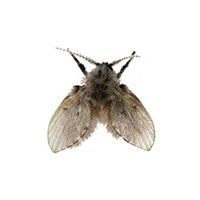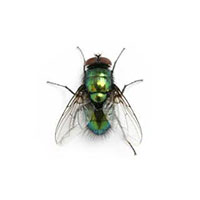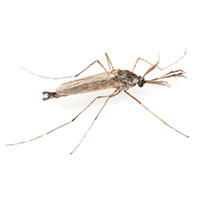House Fly Diet
House flies are general feeders, which means they will eat everything from food to animal and human fecal matter. Since the house fly cannot bite or chew, the mouthparts work like a sponge and soak up liquids. Though they mostly have a liquid diet, they can feed on solid foods by regurgitating saliva and liquefying the food source before consuming it. The diet of the house fly prominently includes moist decaying matter, such as garbage, rotten fruits and vegetables, sewage, animal feces, and sugary substances.
House Fly Habitat
Outdoors can be seen on plants, the ground, fences, compost heaps, and rubbish bins. Once indoors, house flies can be found resting on walls, floors, or ceilings. At night, they prefer to rest near food sources approximately 5 to 15 feet off the ground.
House Fly Life Cycle
The typical female house fly lays her eggs individually or in bunches of 20 to 50, producing between 350 and 900 offspring over the course of her lifetime. Eggs are laid in moist, decaying matter including horse and cow manure, human excrement, decomposing vegetable waste, dumpsters, and trash receptacles, and accumulations of household garbage. Maggots hatch from the eggs in a mere 8 to 20 hours, feed on the decaying matter in which the eggs were laid, and complete three larval molts, called instars, before pupating. House flies spend three to seven days in the larval stage of the life cycle and then travel up to 150 feet to find a cool, dry place to pupate. Depending on the temperature and humidity of the surrounding environment, pupation can take anywhere from a few days to a month to complete. Upon completion, house flies emerge as fully mature adults and typically live for 15 to 25 days. In the right conditions, the pests can develop from eggs to adults in as little as a week.
House Fly Damage & Signs of Infestation
Due to their unhygienic tendencies, house flies are capable of carrying over 100 different pathogens. Problems arise when house flies transfer the pathogens to food items and household surfaces, putting humans at risk of contracting a variety of potentially serious diseases, including cholera, dysentery, typhoid fever, tuberculosis, and salmonella.
Activity
Look for adult house flies around trash cans and other sites containing decaying matter. Seeing adult flies is usually the most common sign of activity and a potential problem. Larvae may also be seen as they crawl out of breeding material to pupate.
Adults
The mere presence of adult house flies often implies that an infestation is nearby, as the insects generally remain within a mile of their birthplace.
Feces
House flies also leave tiny fecal spots called flyspecks on surfaces. In fact, determining the severity of a housefly infestation can be accomplished by strategically placing white spot cards around the home and counting the number of fly specks that appear after a week or so.
House Fly Prevention
When house flies have infested a property, it is important to act fast. A female house fly can lay as many as 900 eggs in her lifetime. While we recommend contacting pest control professionals for effective solutions, there are a number of ongoing activities you can perform to get rid of house flies and keep them from returning. The most effective ways to prevent a house fly infestation involve maintaining a sanitary home environment and barring the pests from entering in the first place.
- Sanitation: Effective sanitation entails removing spoiled food and garbage from the home, regularly cleaning and covering trash cans and recycling bins, and preventing organic matter, such as grass clippings, manure, and weed and compost piles, from accumulating in the yard and decaying.
- Exclusion: Excluding house flies from the home also requires the implementation of preemptive measures, such as checking and tightening window screens, keeping doors closed, and caulking or plugging any openings through which the pests could enter.
- Clean Up After Pets: Animal feces is a known attractant of house flies. Be sure to clean up after pets in the area surrounding your property. Also, house flies are attracted to pet food so remember to make sure no leftover pet food is left out for long periods of time.
House Fly Control
An integrated pest management plan (IPM) based on sanitation and exclusion represents the best approach to take when attempting to control and eradicate an infestation of house flies. Sticky traps, live-capture traps, and insect light traps may help alleviate a house fly infestation.
If a house fly infestation occurs, count on a professional pest management service to take care of the problem knowledgeably and successfully.
Need help with House Flies?
We'll call you! Leave your information below.





